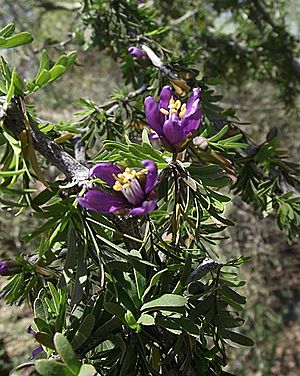Texas guaiacum facts for kids
Quick facts for kids Texas guaiacum |
|
|---|---|
 |
|
| Conservation status | |
| Scientific classification | |
| Genus: |
Guaiacum
|
| Species: |
angustifolium
|
 |
|
| Natural range | |
| Synonyms | |
|
Porlieria angustifolia (Engelm.) A.Gray |
|
The Guaiacum angustifolium is a type of flowering plant. It belongs to the caltrop family, called Zygophyllaceae. People often call it Texas guaiacum or Texas lignum-vitae. Other names include soapbush and huayacán. This plant grows naturally in southern and western Texas in the United States. It is also found in northern Mexico. The name angustifolium comes from Latin words meaning "narrow-leaved."
Contents
Where It Lives
This plant grows near the Rio Grande river. You can find it in places like Austin and San Antonio. It also grows westward towards the Rio Pecos. In the past, smaller plants were seen as "low shrubs" in some areas. The biggest ones grew on hills near the Guadalupe river valley.
What It Looks Like
Texas lignum-vitae is a shrub or a small tree. It has many branches and can grow up to 7 m (23 ft) tall. This plant is an evergreen, meaning its leaves stay green all year. It has a thick canopy and short branches on its sides.
Its Leaves
The leaves are about 1–3 cm (0.39–1.18 in) long. They grow in pairs and have four to eight small leaflets. These leaflets are dark green and feel a bit like leather. They are 5–16 mm (0.20–0.63 in) long and 2–3 mm (0.079–0.118 in) wide. The leaflets can fold up at night or when the sun is very hot.
Its Flowers
The plant has small blue to purple flowers. Each flower is about 12–22 mm (0.47–0.87 in) across. They have five sepals and five petals, which are about 1 cm (0.39 in) long. There are also ten stamens. The flowers bloom from March to September. They often appear after it rains.
Its Fruit
The fruit is a flat, leathery capsule. It is 1–2 cm (0.39–0.79 in) wide. It usually has one or two sections, but sometimes up to four. These sections open up to show one shiny, bean-like seed. The seed is usually bright red.
How People Use It
The wood of the Texas lignum-vitae is very hard and heavy. It will even sink in water! The outer part of the wood, called sapwood, is creamy yellow. The inner part, called heartwood, is dark purple-brown. People use this wood for fence posts, tool handles, and firewood.
Some people use extracts from the roots to help with rheumatism. The bark of the roots contains saponin, which can be used to make soap. This soap was historically used to wash wool because it did not make the colors fade. The root bark is also used as a disinfectant.
Beekeepers like the flowers because they consistently produce nectar for bees. This plant is also grown as an ornamental plant in gardens. It is popular because it can handle dry weather. It also has thick leaves, a small size, twisted branches, and sweet-smelling flowers. You might see it in hedges, rock gardens, or in xeriscaping (gardens that need little water).
Its Role in Nature
The Guaiacum angustifolium is a host plant for certain caterpillars. For example, the caterpillars of the lyside sulphur butterfly (Kricogonia lyside) eat its leaves. The leaves also contain a lot of protein (16-18%). White-tailed deer like to eat them.
Protecting the Plant
Like other plants in its genus, the international trade of Texas lignum-vitae is controlled. This is done by an agreement called CITES Appendix II. This means that only seeds, pollen, and finished products (like carved items ready to sell) can be legally sent out of a country.


